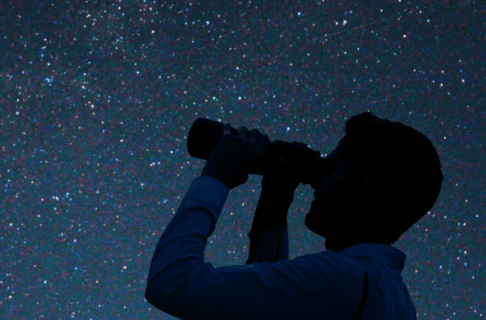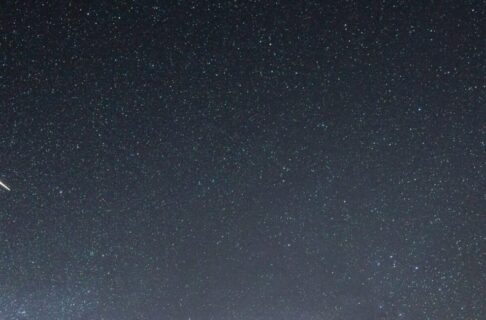Posted on: Monday October 6, 2014
UPDATE – 7 October 2014: Remember, the eclipse occurs after midnight TONIGHT! Weather forecast is not looking great for Winnipeg, but viewers farther west may have a clear view.
Original article: The full moon in October is referred to as the Harvest Moon, since it rises as the sun sets and so would provide farmers an extra hour or so of light to finish bringing in their harvest. Full Moon is also the only time we can have a lunar eclipse, and this month we get both events occurring together.
A lunar eclipse occurs whenever the moon moves into the earth’s shadow. Many people don’t think about it, but the moon is just a big rock in space – it doesn’t give off any light of its own. The only reason we see the moon at all is that the sun is shining on it, and that light is reflected to us here on Earth. If you look at the moon when it is near First Quarter phase, this is easiest to see: the half of the moon facing the sun is lit up, and the half of the moon facing away from the sun is dark. (Of course, this is true for the earth as well – the side of Earth facing the sun is lit up and experiencing daylight, while the side of the earth facing away from the sun is dark and experiencing night.)
So, what can prevent sunlight from lighting up the moon? It turns out that there is only one thing big enough and close enough to do that – our planet, the Earth. If things line up just right, the moon will move into the shadow of the earth, and so sunlight will be blocked from lighting up the moon. This creates what we call a lunar eclipse. Lunar eclipses aren’t particularly rare; there is usually one or two a year visible somewhere in the world.
A Word about Safety
The word “eclipse” can conjure images of special safety glasses and people staying inside to avoid going blind, but those warnings refer to eclipses of the sun (which we will have in a couple of weeks, but that is the subject of another blog!) Viewing a lunar eclipse has absolutely NO risk of eye damage and does not require any special equipment (although a pair of binoculars or a telescope can enhance the view).
This week’s lunar eclipse early on Wednesday morning, between about 3 am and 7 am (details below). This means, of course, that for many folks it’s really a Tuesday night event, since once you wake up on Wednesday the event will be over. Make sure you set your alarm or stay up late on the correct date! On the plus side, the eclipse is a slow, stately event, and so you can peek out every few minutes or so and then warm up inside without missing too much.
Eclipse Timeline
All events are given in Central Daylight Time, the local time for Manitoba.
Tuesday, Oct 7 – evening – the eclipse starts in just a few hours, so make sure you have set your alarm and have all of your gear ready to go. A clear morning sky in October can be cold, so make sure you are dressed for winter, not fall. You will want a clear view of the southwest and west horizon, with as few trees or buildings in the way. Unlike most events, you don’t need to get away from city lights, although it helps.
Wednesday, Oct 8, 3:15 a.m. – the beginning of the eclipse is a very subtle thing. The Earth’s shadow is not hard-edged, but fuzzy, so the eclipse sort of “fades in” very slowly. Sharp-eyed viewers will start to notice that the left edge of the moon is getting dusky sometime before 4 a.m., but exactly when depends both on the observer and the atmospheric conditions around the world. It’s something not predictable in advance, so you just have to go out and see. Over the next hour, the moon will grow darker on the left edge, and probably start to take on an orange or red hue. As the eclipse begins, the moon is over in the southwestern sky, about a third of the way from the horizon to the point straight overhead. Over the next few hours, the moon will move down and to the right, so make sure you can see clear to the western horizon.
Wednesday, Oct 8, 4:14 a.m. – the moon begins to enter the darker central part of the Earth’s shadow (called the umbra). The moon is definitely getting darker from the left, and over the next while it will look as if the Earth’s curved shadow is creeping across the moon’s face. Actually, it is the moon which is moving towards the left into the shadow – if you are watching with binoculars, check the moon’s position against the background stars and you’ll see this slow motion. Over the next hour or so, the moon will get very dark as it moves completely into Earth’s Shadow. (Incidentally, observing this phase of the eclipse provides proof that the Earth is round – you can see that the Earth’s shadow is curved, not straight.)
Wednesday, Oct 8, 5:25 a.m. – the moon is totally eclipsed, completely within the shadow of the Earth. Despite this, the moon likely won’t disappear completely. The Earth blocks direct sunlight from striking the moon, but the Earth’s atmosphere acts like a lense and bends light from around the edges of the Earth. Because of the geometry, the only light that can hit the moon is the light from all of the sunrises and sunsets all around the world at that particular moment – those glorious reds, oranges, and pinks that we can see as the curtain goes up on a clear night. During the total phase, the moon can take on a red or orange colour, depending on the conditions around the world at that time. Because of this, every lunar eclipse is different – some are very bright, others almost black. The forecast for this year is for a brighter-than-average eclipse, based on the amount of volcanic dust and so on in the atmosphere, but this isn’t definitive.
Wednesday, Oct 8, 5:54 a.m. – Mid-eclipse, with the moon at its darkest. By this point, the moon is low on the western horizon, making for a dramatic photo-opportunity for those who have a building or other landmark to your west on eclipse night.
Wednesday, Oct 8, 6:24 a.m. – the total phase of the eclipse ends, as the moon starts to move out of the Earth’s umbral shadow. At this point, the moon is low in the west and the sky is already beginning to brighten in the east. Depending on how dark the eclipse is, it may be tough to spot the moon without looking carefully.
Wednesday, Oct 8, 7:30 a.m. – the moon has exited the earth’s umbral shadow, ending the partial phase of the eclipse. While there is still some eclipse shadow going on with the fainter outer shadow of the Earth (the penumbra), it likely will be lost in the growing twilight and the moon’s proximity to the horizon.
Wednesday, Oct 8, 7:40 a.m. – the sun rises, and the moon sets 11 minutes later, with the penumbral eclipse still in progress.
Enjoy the view – because of the late hour, there is no public viewing planned for this eclipse, but you can enjoy it with the unaided eye, or a pair of ordinary household binoculars or a small telescope if you have one.





